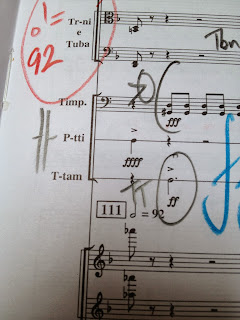What do I mean by "score marking"? Well, contrary to the opinion of some orchestral musicians, conductors scores are not filled with diagrams and comments like this.........
So if a score is not filled with such helpful diagrams, what does a conductor write in their score?
At this point, I should note that some conductors write little or nothing in their scores. Some find it a distraction, some are lucky enough to have a photographic memory (I believe Lorin Maazel is in this category) and some just add some very small pencil markings where necessary. This is perfectly acceptable - there is, in my opinion, no right or wrong when it comes to how you treat and use your scores.
Other conductors, like me, write all manner of information in their scores. Why? Firstly, it is a really good way of learning a score. Not wishing to sound too big-headed, but after 20 years of playing the violin professionally, I know most pieces in the repertoire very well. But even with this exposure, you find things in a score every time you look at it, your ideas and thoughts on a piece change, so it is worth writing it down.
So, how do I start?
Firstly, I do my preliminary work. I go through the score from start to finish drawing a red line between the systems, should a page have more than one system on it, like this......
But while I am doing this, I add another marking. Here is an example......
This is a little marking telling me that on the previous page, Fig.70 is one bar away. Or, should I say that the first bar on this page is 2 bars after Fig.70. The reason for doing this is apparent when you are rehearsing. Often, when looking for somewhere to start, a conductor will leaf through his score trying to find a rehearsal figure – often they are far apart, often they are just over a page. Knowing where these rehearsal marks are helps cut down on time wasted but there is a second benefit. As I said, the first bar of that page is 2 after Fig.70. But if you didn’t know that, you could have asked the orchestra to go from 8 bars before Fig.71, as this is equally true. This means less time spent for the musicians to count out their bars and avoids the inevitable smart ass comment, “you mean 2 after 70?”
Trust me, it takes time writing them in, but it saves rehearsal time!
So having done the “boring stuff”, what next?
I use coloured pencils to mean different things. I use red to signify anything I to do with beating time, tempo, accelerandos, rits etc. Some typical tempo markings are shown in this next photo......
You may also have noticed some blue – any blue markings are for dynamics, articulations and balance. Often all I am doing is making the composers markings more visible, especially in smaller sized scores. It is good to glance down and see something clearly and quickly when required.
Next are cues. Some publishers don’t list the instruments on the left hand side of every page, and some cues need marking in any way as the player has been inactive for a long time. For this I use a normal 3B pencil and mark something like this.......
What you see here is my sign for timps, clashed cymbals and tam-tam. You can use any abbreviation you like, but I use the following, which, I hope, are fairly self explanatory!
Fls ( or Fl 1 for just First Flute)
Po
Obs (Ob1)
CA
Kls (K1)
BKl
Fg (Fg1)
Cfg
HNS (H1, H2 etc)
Tpt
Tbn
Tba
Hp
V1
V2
VA
Vc
Cb
As I said, you can use your own, but it is a good idea to make them easily recognisable at a very quick glance. You could argue my markings for Trumpet, Trombone and Tuba look a little similar but I am stuck with them now! (I could, and maybe should have used POS for the trombone?)
There, in a nutshell, is how I mark my scores. Extra to this, I write in bowings, slurrings, phrase shapes, historical references if needed, notes to myself on balance, misprints I might have discovered over the years (and they are many!), colours I might strive to achieve, tempo thoughts and how they relate to the architecture of the piece – the list is endless! I am big enough to admit that whilst a lot of this is carried around in my head, some of it is not and it is worth noting it down and having it there for posterity.
One word of caution – if, as happened to me in 2011, you have to use someone else’s score, or you lose yours (or an airline loses it for you!), you must be flexible enough to quickly put some simple pencil markings in a new score at a moments notice.
In the end, marking up a score must serve one purpose more than any – to help you learn the piece to such an extent that your head is no longer in the score! It seems a little bizarre to say it, but it is true. The greatest feeling of all is conducting without a score, but until then, and especially in rehearsal, your score should be your bible and your friend and if it takes markings to help, then so be it.
I promise my next post will be sooner rather than later - until then, happy marking!





No comments:
Post a Comment